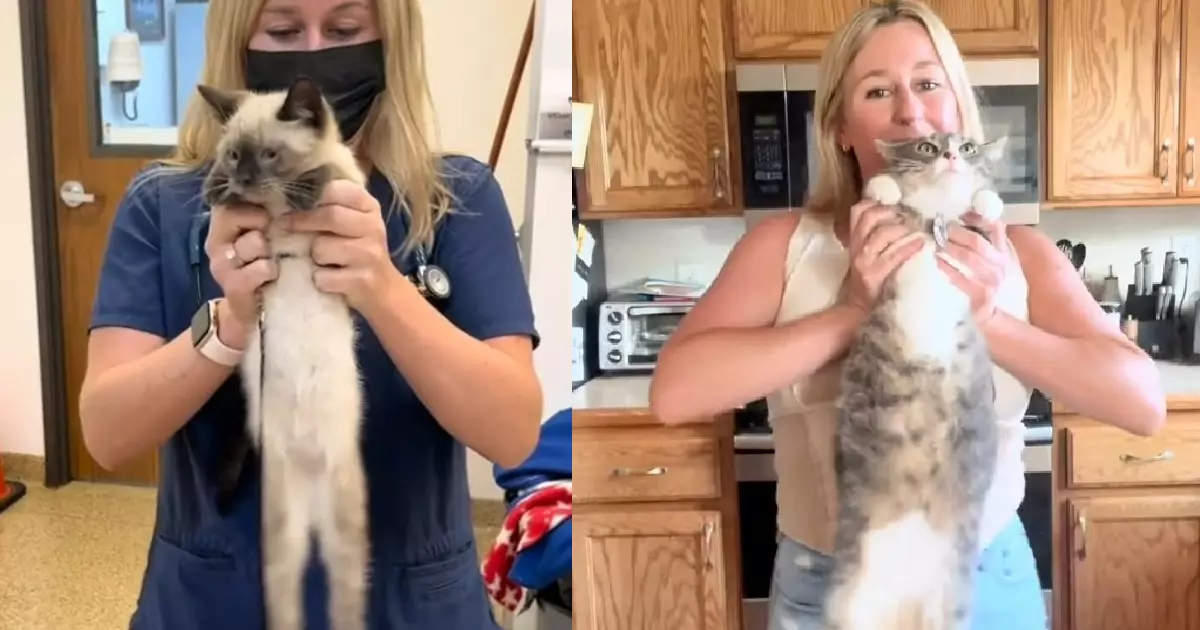For decades, pet owners and veterinarians alike have relied on age-old beliefs and seemingly whimsical tests to gauge a cat’s personality—superstitions, old wives’ tales, and folklore that often sound more charming than scientifically validated. Among these, the so-called “dangle test”—an old veterinary wives’ tale—has resurfaced with renewed popularity thanks to social media platforms like TikTok. While initially dismissed as mere entertainment, this test raises profound questions about the ways we interpret animal behavior and whether such traditional methods hold any real insight into feline temperament.
In essence, the “dangle test” involves suspending a kitten or cat gently by the scruff or limbs to observe its reaction. Classic proponents suggest that a cat that remains relaxed and undisturbed will be docile and adaptable adults. However, superficial charm and viral trends should not obscure the critical need to scrutinize the scientific validity of these claims. As a critic, I must emphasize that relying solely on such anecdotal methods risks oversimplification, ignoring the complex psychological and emotional dimensions that shape feline personalities.
The key issue with this test—and similar folklore—is the danger of confirming biases. Pet owners are eager for quick, easy ways to interpret their furry friends, especially in the age of viral videos and instant gratification. Yet, a relaxed demeanor during a brief suspension may simply reflect a cat’s current mood, tolerance level, or comfort with human handling—not necessarily a predictor of future behavior or temperament. It’s unfortunate that many fall prey to the misconception that a single test can provide definitive insights into a creature’s character, ignoring the multifaceted and context-dependent nature of animal personalities.
Unpacking the Scientific and Ethical Limitations
From a scientific perspective, the “dangle test” lacks objective validation. Behavioral diagnostics in animals are inherently complex, requiring nuanced assessments over time and in varied contexts. No single physical or observational test—especially one as arbitrary as dangling a cat—can reliably predict future temperament or behavior. Professional animal behaviorists typically employ standardized tools like temperament assessments, behavioral histories, and observational studies to gain a fuller picture of an animal’s disposition.
Moreover, the test raises ethical concerns. While some cats may tolerate gentle suspension, others can experience stress, fear, or even physical discomfort, which might damage the bond with their owners or exacerbate underlying anxieties. In a compassionate and scientifically responsible framework, pet owners should prioritize patience, positive reinforcement, and stress-free bonding over superficial tests that risk distress or misinterpretation.
It’s crucial to recognize the modern shift toward evidence-based animal behavior practices. Traditional tales and viral challenges must give way to respectful, scientifically grounded methods that honor each pet’s individuality. Instead of trying to shoehorn cats or dogs into preconceived categories through questionable tests, owners should invest time in understanding their pets’ unique signals, preferences, and boundaries. Genuine understanding comes from consistent, empathetic engagement—not from manipulating animals into awkward or uncomfortable positions.
The Power of Modern Education and Responsible Pet Ownership
The resurgence of interest in old wives’ tales like the “dangle test” underscores a broader societal tendency to seek instant answers to complex questions. As pet owners, many are eager to decode their companions’ personalities at a glance, but real insight requires education, patience, and humility. Veterinary professionals and animal behaviorists advocate for responsible ownership practices rooted in compassion and scientific rigor, fostering strong bonds built on mutual trust rather than fear or superficial judgments.
Social media, despite its entertainment value, should serve as a platform for promoting authentic, responsible pet care. Viral trends can be alluring, but they also risk spreading misinformation. It’s incumbent on veterinary communities and animal advocates to leverage these platforms to disseminate accurate information and challenge questionable methods cloaked as ‘tricks of the trade.’
Finally, recognizing the individuality of each pet is paramount. Cats, in particular, are known for their enigmatic personalities; attempting to categorize them through simplistic tests risks ignoring their nuanced emotional worlds. By embracing comprehensive behavioral understanding, pet owners can cultivate meaningful relationships, nurture well-adjusted animals, and reject superficial stereotypes. Instead of relying on outdated tales, let’s prioritize education and empathy—these are the true keys to unlocking the authentic spirit of our feline friends.

